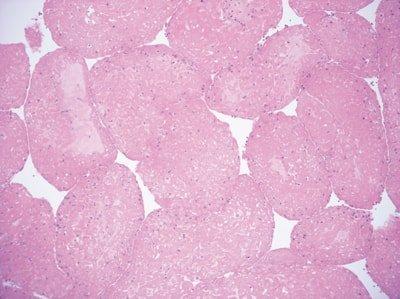
Steps to Better Grossing

From patient to pathologist, preparing tissue specimens for histological examination requires care, skill and sound procedures. This guide provides practical advice on best practice techniques and simple ways to avoid common errors.
Tips for better grossing are highlighted in this guide. We hope each step provides a valuable reminder of good histology practice and also helps with troubleshooting when unacceptable results do occur.
Check Fixation Status
Specimens are dealt with promptly (especially large specimens that may otherwise be inadequately fixed).
No consideration given to optimizing the fixation of problem specimens.

Prepare Thin Slices
Care is always taken to prepare uniform, thin slices from large specimens (3–4 mm maximum thickness). This is particularly important with dense tissues.
Slices are sometimes 6 mm (or more) thick and are often uneven.

Avoid Specimen Trauma
Care is taken to avoid traumatizing delicate specimens, particularly those that are incompletely fixed (handle carefully, do not crush, always use sharp blades).
Specimens are handled roughly without any consideration as to their state of fixation. Sometimes blunt blades are used in dissection.

Avoid Cross-contamination
Each specimen is handled on a clean surface avoiding the possibility of specimen-to-specimen contamination.
Sometimes the surface of the cutting board is not properly cleaned between specimens. This is of concern when the same specimen types are cut up one after the other. You do not want to have carry over from a specimen that is malignant to one that is benign.

Take Care with Biopsy Pads
Fresh or incompletely fixed specimens are not placed between foam biopsy pads, particularly needle-core specimens (biopsy pad artifact is avoided).
Sometimes small, fresh or incompletely fixed specimens are placed between biopsy pads, put into a cassette and then fixed. This can produce a characteristic artifact.

Choose Appropriate Cassettes
Choose appropriate cassettes for the specimen type being processed. Tissue fragments shrink during processing and, if cassette perforations are too large, fragments may escape into processing reagents or, worse still, transfer over to another specimen.
A “one size fits all” approach is used when placing specimens into cassettes.

Avoid Overloading Cassettes
Cassettes are never overloaded with tissue thus allowing ready access to processing reagents and preventing distortion of specimens. If the volume of tissue is too great a second cassette is used.
Cassettes are often crammed full of tissue thus preventing access of processing reagents. Sometimes specimens are distorted in the process.

Clearly Label Cassettes
Cassettes are always clearly labeled. Accurate identification of specimens is of paramount importance.
Sometimes it is difficult to read the labels on cassettes. A bit of guess work may be required.

발표자 소개

Geoffrey Rolls is a Histology Consultant with decades of experience in the field. He is a former Senior Lecturer in histopathology in the Department of Laboratory Medicine, RMIT University in Melbourne, Australia.
Related Content
라이카 바이오시스템즈 Knowledge Pathway 콘텐츠는 에서 이용할 수 있는 라이카 바이오시스템즈 웹사이트 이용 약관의 적용을 받습니다. 법적고지. 라이카 바이오시스템즈 웨비나, 교육 프레젠테이션 및 관련 자료는 특별 주제 관련 일반 정보를 제공하지만 의료, 규정 또는 법률 상담으로 제공되지 않으며 해석되어서는 안 됩니다. 관점과 의견은 발표자/저자의 개인 관점과 의견이며 라이카 바이오시스템즈, 그 직원 또는 대행사의 관점이나 의견을 나타내거나 반영하지 않습니다. 제3자 자원 또는 콘텐츠에 대한 액세스를 제공하는 콘텐츠에 포함된 모든 링크는 오직 편의를 위해 제공됩니다.
모든 제품 사용에 다양한 제품 및 장치의 제품 정보 가이드, 부속 문서 및 작동 설명서를 참조해야 합니다.
Copyright © 2025 Leica Biosystems division of Leica Microsystems, Inc. and its Leica Biosystems affiliates. All rights reserved. LEICA and the Leica Logo are registered trademarks of Leica Microsystems IR GmbH.



